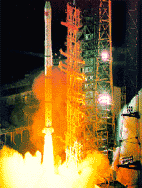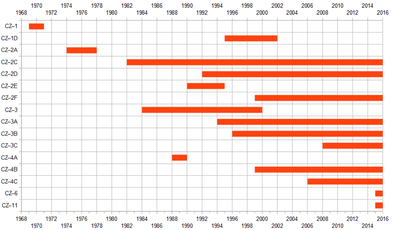لونگ مارش (عائلة صواريخ)
صاروخ لونگ مارش (الصينية المبسطة: 长征系列运载火箭; الصينية التقليدية: 長征系列運載火箭; پنين: Chángzhēng xìliè yùnzài huǒjiàn) أو الصاروخ تشانگژنگ بالصينية هو أي صاروخ في عائلة expendable launch systems operated by the People's Republic of China. Development and design falls under the auspices of the China Academy of Launch Vehicle Technology. In English, the rockets are abbreviated as LM- for export and CZ- within China, as "Chang Zheng" means "Long March" in Chinese pinyin. The rockets are named after the Long March of Chinese communist history.
التاريخ


China launched its first satellite, known as Dong Fang Hong 1 (lit. "The East is Red 1"), into Earth orbit on its Long March space rocket on April 24, 1970, becoming the fifth nation to achieve independent launch capability. Early launches had an inconsistent record, focusing on launching of Chinese satellites.
التنويعات
The Long March rockets are organized into several series:
- لونگ مارش 1 rocket family
- لونگ مارش 2 rocket family
- لونگ مارش 3 rocket family
- لونگ مارش 4 rocket family
- لونگ مارش 5 rocket family
- لونگ مارش 6 rocket family
- لونگ مارش 7 rocket family
| الموديل | الوضع | المراحل | الطول (m) |
أقصى قطر (م) |
كتلة الانطلاق (طن) |
دفع الانطلاق (kN) |
الحمولة (LEO، كج) |
الحمولة (GTO، كج) |
|---|---|---|---|---|---|---|---|---|
| لونگ مارش 1 | Retired | 3 | 29.86 | 2.25 | 81.6 | 1,020 | 300 | - |
| لونگ مارش 1D | Retired | 3 | 28.22 | 2.25 | 81.1 | 1,101 | 930 | - |
| لونگ مارش 2A | Retired | 2 | 31.17 | 3.35 | 190 | 2,786 | 1,800 | - |
| لونگ مارش 2C | Active | 2 | 35.15 | 3.35 | 192 | 2,786 | 2,400 | - |
| لونگ مارش 2D | Active | 2 | 33.667 (without shield) |
3.35 | 232 | 2,962 | 3,100 | - |
| لونگ مارش 2E | Retired[1] | 2 (plus 4 Strap-on boosters) |
49.686 | 7.85 | 462 | 5,923 | 9,500 | 3,500 |
| لونگ مارش 2E(A) | canceled[2] | 2 (plus 4 Strap-on boosters) |
53.60 | N/A | 695 | 8,910 | 14,100 | - |
| لونگ مارش 2F | Active | 2 (plus 4 Strap-on boosters) |
58.34 | 7.85 | 480 | 5,923 | 8,400 | 3,370 |
| لونگ مارش 3 | Retired[1] | 3 | 43.8 | 3.35 | 202 | 2,962 | 5,000 | 1,500 |
| لونگ مارش 3A | Active | 3 | 52.52 | 3.35 | 241 | 2,962 | 8,500 | 2,600 |
| لونگ مارش 3B | Active | 3 (plus 4 Strap-on boosters) |
54.838 | 7.85 | 426 | 5,924 | 12,000 | 5,100 |
| لونگ مارش 3B/E | Active | 3 (plus 4 Strap-on boosters) |
56.326 | 7.85 | 458.97 | ? | ? | 5,500 |
| لونگ مارش 3B(A) | In development | 3 (plus 4 Strap-on boosters) |
62.00 | 7.85 | 580 | 8,910 | 13,000 | 6,000 |
| لونگ مارش 3C | Active | 3 (plus 2 Strap-on boosters) |
55.638 | 7.85 | 345 | 4,443 | ? | 3,800 |
| لونگ مارش 4A | Retired | 3 | 41.9 | 3.35 | 249 | 2,962 | 4,000 | (SSO) 1,500 |
| لونگ مارش 4B | Active | 3 | 44.1 | 3.35 | 254 | 2,971 | 4,200 | (SSO) 2,200 |
| لونگ مارش 4C | Active | 3 | 45.8 | 3.35 | 2,971? | 4,200 | (SSO) 2,800 | |
| لونگ مارش 5[3][4] | Active | 3 | 62 | 5 | 867 | N/A | 25,000 | 14,000 |
| لونگ مارش 6[5][6] | Active | 3 | 29 | 3.35 | 103 | (SSO) 500 | ||
| لونگ مارش 7 | Active | 2 | 57 | 3.35 | 594 | 7200 | 13,500 | 7000[7] |
| لونگ مارش 8 | In study | |||||||
| لونگ مارش 9 | In study | 8 to 10[8] | 3000 | 130,000 | 50,000 | |||
| لونگ مارش 11 | Active | 3 solid( +1 liquid?) | 20.8 | ~2 | 58 | 700 | (SSO) 350 |
| 2A | 2C | 2D | 2E | 2F | 3 | 3A | 3B | 3C | 4A | 4B | 4C |
|---|---|---|---|---|---|---|---|---|---|---|---|
 |
 |
 |
 |
 |
 |
 |
 |
 |
 |
 |

|
لونگ مارش 8
A new series of launch vehicles in study, which is geared towards SSO launches.[9]
لونگ مارش 9
Long March 9[10] (LM-9, CZ-9, or Changzheng 9, Chinese: 长征九号) is a Chinese super-heavy carrier rocket that is currently in study. It is planned for a maximum payload capacity of at least 130,000 kg[11] to LEO or at least 50,000 kg to Lunar Transfer Orbit.[12] Its first flight is expected in 2025 in preparation for a manned lunar landing in 2029.[بحاجة لمصدر] If produced, it would be classified as a Super Heavy lift launch vehicle along with the American Saturn V and unsuccessful Soviet N1; and the Space Launch System and Falcon Heavy currently under development in the United States.
لونگ مارش 11
The Long March 11 is a solid-fuel rocket that applies China's largest solid-fuel rocket engine and was designed to meet the need to rapidly launch satellites in case of emergencies or disasters. Its first launch on 25 September 2015, was reported to be successful and launched 4 micro satellites into sun synchronous orbits.[13][14]
خدمات الإطلاق التجارية
China markets launch services under the China Great Wall Industry Corporation.[15] Its efforts to launch communications satellites were dealt a blow in the mid-1990s after the United States stopped issuing export licenses to companies to allow them to launch on Chinese launch vehicles out of fear that this would help China's military. In the face of this, Thales Alenia Space built the Chinasat-6B satellite with no components from the United States whatsoever. This allowed it to be launched on a Chinese launch vehicle without violating U.S. ITAR restrictions.[16] The launch, on a Long March 3B rocket, was successfully conducted on July 5, 2007. A Chinese Long March 2D launched Venezuela's VRSS-1 (Venezuelan Remote Sensing Satellite 1) "Francisco de Miranda" on September 29, 2012.
انظر أيضاً
- China National Space Administration
- Shenzhou spacecraft
- برنامج الفضاء الصيني
- Tsien Hsue-shen
- Comparison of orbital launchers families
- Comparison of orbital launch systems
الهامش
- ^ أ ب "CZ". Astronautix.com. Retrieved 2010-08-10.
- ^ "CZ-2EA地面风载试验". 中国空气动力研究与发展中心. February 4, 2008. Retrieved June 30, 2008.
- ^ "cz5". SinoDefence.
- ^ "CZ-NGLV". astronautix.com.
- ^ "China starts developing Long March 6 carrier rockets for space mission _English_Xinhua". News.xinhuanet.com. September 6, 2009. Retrieved 2010-08-10.
- ^ "ChangZheng 6 (Long March 6) Launch Vehicle". SinoDefence.com. February 20, 2009. Retrieved 2010-08-10.
- ^ "长征七号运载火箭". baidu.com.
- ^ "China develops new rocket for manned moon mission: media". spacedaily.com.
- ^ http://www.chinanews.com/mil/2015/03-07/7109962.shtml
- ^ http://www.chinesedefence.com/forums/chinese-strategic-forces/3353-cz-9-chinas-next-gen-rocket-moon-landing.html
- ^ "First Look: China's Big New Rockets". AmericaSpace.
- ^ 509. "梁小虹委员:我国重型运载火箭正着手立项 与美俄同步". people.com.cn.
{{cite web}}:|author=has numeric name (help) - ^ Xinhua (2013-03-02). "China's first solid-fuel rocket to debut before 25 September 2016". chinadaily.com.cn. Retrieved 2013-03-04.
- ^ "长征十一号运载火箭首飞成功 将4颗微小卫星送入太空". xinhuanet.com.
- ^ "About CGWIC". CGWIC.
- ^ "China launches satellite despite restrictions". USA Today. July 6, 2007. Retrieved May 11, 2010.
وصلات خارجية
- CS1 errors: numeric name
- Articles containing simplified Chinese-language text
- Articles containing traditional Chinese-language text
- Articles with hatnote templates targeting a nonexistent page
- Articles with unsourced statements from November 2016
- Portal templates with default image
- أنظمة اطلاق متعددة المراحل
- 1970 في ارتياد الفضاء
- لونگ مارش (عائلة صواريخ)
- عائلات صواريخ
- Space launch vehicles of China

